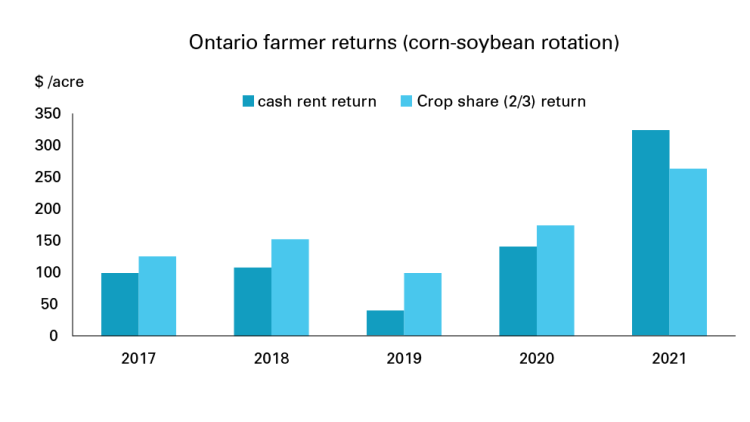Crop sharing or cash rate land rental agreements – which is right for your operation?

High demand for farmland and limited opportunities to acquire land has led to an average increase in farmland values of 8.3% in 2021. Renting farmland can be a more affordable option to scale up farming operations. Cash rental rates as a percent of the purchase price declined slightly from 2.7% in 2020 to 2.5% in 2021 at the national level. Land rental agreements are generally multi-year agreements that result in lags between changes in the operating environment and adjustments in cash rental rates. The robust market farmland makes it critical to understand the drivers of affordability of farmland ownership and the profitability of different rental agreements.
Farmland rental agreement needs to meet the objective of both parties
There are two main types of farmland rental agreements in Canada:
1. Cash rent
Cash rent is the most common agreement because of its simplicity, and the rent price is fixed for at least one year giving certainty to both the landowner and producer. The farm operator bears all risks and receives all gains from changing prices of outputs, inputs and yields.
2. Crop share agreement
Crop share agreements are traditionally based on a one-third/two-thirds or one-quarter/three-quarters split of the crop between the landlord and the producer. The landlord contributes the land and a portion of the crop inputs (e.g., seed, fertilizer, chemicals, crop insurance) while the producer supplies all the machinery, labour, and remaining inputs.
No single type of rental agreement is best under all conditions
We measure the profitability using provincial average yields and average prices to estimate revenue minus average costs of production on a per-acre basis between the two rental types.
The last 5 years (2017-2021) produce different profitability outcomes under the two cash rental arrangements. In Ontario, we found that on average, overall farmer returns were 14% higher for a 1/3 - 2/3 crop share agreement than pure cash rental agreement (Figure 1). The crop-share arrangement generated a higher return in 4 of the 5 years. In the case of a 1/4 - 3/4 split, the crop share arrangement becomes a better alternative under all scenarios.
Figure 1: Historical crop share and cash rent returns Ontario farmer perspective

Source: FCC computations.
In Saskatchewan, the analysis was less conclusive (Figure 2). The cash rental arrangement generated a more pronounced negative return in 2019 while generating a stronger positive return in 2020 than the 2/3 crop share. Crop sharing generated returns that were less variable. While cash rental arrangements offer certainty with land costs, it still involves a degree of variability in profits. As in Ontario, the 3/4 crop share returns were always higher than cash rental returns between 2017-2021.
Figure 2: Historical crop share and cash rent returns Saskatchewan farmer perspective

Source: FCC computations.
What are key considerations when entering different rental agreements?
One benefit of a crop-share agreement should be viewed through the lens of risk mitigation during periods of tight or negative margins.
According to the last Census of Agriculture, a small percentage (8%) of rented land in Canada is farmed under crop sharing arrangements. Crop sharing can be complex, and it comes down to an individual’s risk preferences. Rental agreements must be tailored to the needs of both the producer and the landlord. Explore using crop share leases as another tool to mitigate risk.
Leigh Anderson
Senior Economist
Leigh Anderson is a Senior Economist at FCC. His focus areas include farm equipment and crop input analysis. Having grown up on a mixed grain and cattle farm in Saskatchewan, he also provides insights and monitoring of Canada’s grain, oilseed and livestock sectors.
Leigh came to FCC in 2015, joining the Economics team. Previously, he worked in the policy branch of the Saskatchewan Ministry of Agriculture. He holds a master’s degree in agricultural economics from the University of Saskatchewan.

